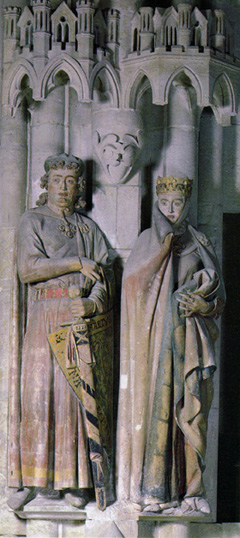After two days in Dresden, I took a train to Naumburg. My plan was to see Naumburg’s famous cathedral, take a Nietzsche pilgrimage in and around Naumburg, and then go on to Weimar, Ilmenau, etc. As it turned out, I lingered in Naumburg, and didn’t make it to Weimar or Ilmenau or Nietzsche’s birthplace (Rocken). The Naumburg hostel gave me a bike, and I rode along the nearby rivers, the Saale and the Unstrut. The bike-paths are good — free of cars, well marked, flat. I passed numerous farms as I rode, and I saw crops like wheat that I rarely see in the U.S. Wheat often grew in flat areas, while grapes grew on steep hillsides — so steep that it seemed impossible for a farmer to work there. From the hilltops, I could see numerous windmills, used to generate electricity.
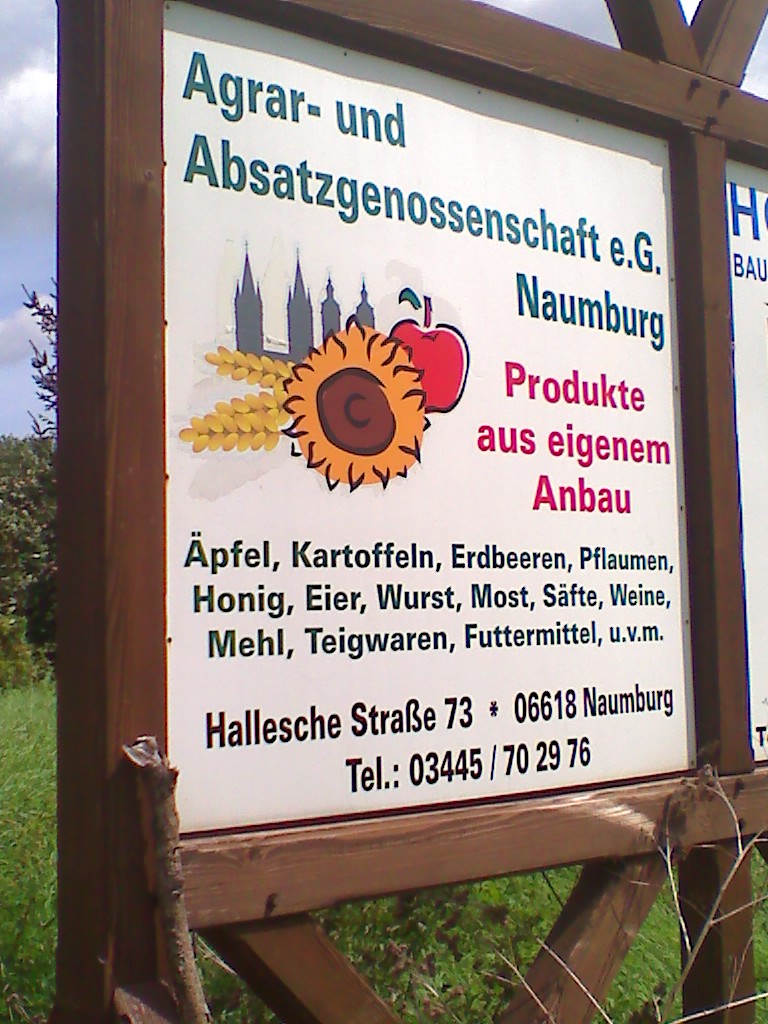
|
| A sign along the bike-path, listing local farm-products: Apple, potato, strawberry, plum, honey, eggs, sausage, cider, juice, wine, flour, pasta, feed for animals |
When I cycled from Naumburg to Freyburg, I rode a small ferry across the narrow river. Before there were bridges, there were ferries (the mythical river Styx, for example, had a ferry operated by Charon, not a bridge).

|
| A canoe on the Unstrut River. |
The ride from Naumburg to Freyburg is short and pleasant. Looming over Freyburg is Neuenburg castle, a large, ancient, well-preserved castle. The audio tour of the castle is so long that your energy will run out before the tour ends. An audio tour isn’t as good as a living-person tour since you can’t ask questions, and it’s difficult to find your way, etc. Freyburg should not be confused with the larger, better-known city of Freiburg, which has a famous university, and is in the southwest corner of Germany, near the Black Forest.
My next ride was along the Saale river to Schulpforta, a private school that Nietzsche attended. The school attracts more tourists and Nietzsche pilgrims than I expected; it even has week-long Nietzsche seminars in the summer. Tourists are invited to take an audio tour that’s long and detailed, but says very little about Nietzsche. I tried to engage the librarian in conversation, but she said I could only look at the library for “one minute.” So when I left the school, I hadn’t acquired a single Nietzsche anecdote. If I go to this area again, I’ll visit the Nietzsche House in Naumburg, which wasn’t open when I passed by.
Schulpforta was originally a monastery, started in the 1100’s, and some of the ancient buildings are still standing. The monastery became a school in the 1500’s, when the Reformation closed monasteries. Schulpforta has a mill pond, and once had its own paper mill, which produced paper for the school. Besides Nietzsche, the school has other famous graduates, such as the philosopher Fichte, and the historian Leopold von Ranke.1
There’s a long bike-path along the Saale, and also a bike-path along the Ilm, which you could take to Weimar and Ilmenau. (The Ilm flows into the Saale about ten miles southwest of Naumburg.)
|
|
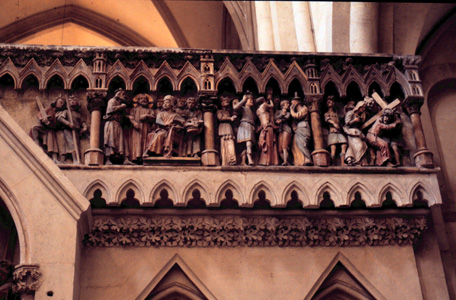
|
| The west choir screen. |
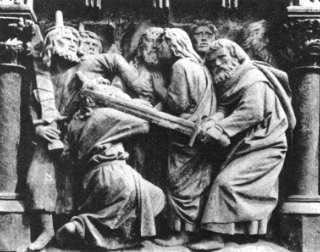
|
| From the west choir screen, the kiss of Judas, Peter de-earing Malchus. |
While a big city like Prague seems to have too many tourists, a small city like Naumburg may have too few tourists; as a tourist in Naumburg, you may feel out-of-place, you may feel that you don’t belong. Perhaps a solo traveler, like myself, is especially prone to feel this way. I spoke to a solo traveler from Australia who said, “Next time, I’ll bring someone with me.” He seemed to feel that it wasn’t enjoyable to travel alone. Perhaps we shouldn’t expect solo traveling to be enjoyable, and shouldn’t try to enjoy it; perhaps we should just go through it, just do it. Proust said that happiness comes, not when we pursue it directly, but as a by-product of pursuing other things. Perhaps we should regard traveling as a learning experience; like other learning experiences, traveling has as many pains as pleasures. We may look back on our travels as a good experience, as enjoyable, though they aren’t enjoyable at the time.
After three days in Naumburg, I took a train to Berlin. Like Prague, Berlin has become a city that tourists are drawn to, a city that’s part of the “standard tour of Europe.” The people in Berlin reminded me of New Yorkers: they want to be cutting-edge, they want to stand out. Berlin has a large gay population, and a gay mayor. Like New York, Berlin is known for its museums; the Pergamon is especially famous. I enjoyed my walking tour of Berlin; the guide (Tim) talked about the Cold War era, when Berlin was divided by the Berlin wall. He told stories of escapes to West Berlin, and showed us the stately squares built under Frederick the Great in the 1700’s, such as Bebelplatz and Gendarmenmarkt. Many of Berlin’s older buildings are built in a classical style — more impressive, perhaps, than Prague’s Baroque buildings, but less charming.
Our guide described how Prussia, based in Berlin, expanded during the 1700’s and 1800’s, until finally it absorbed the other German states, and created the German Empire in 1871. Germany was then larger than it is today, stretching far to the east, along the Baltic coast.
There’s a fountain in Berlin called the Fountain of Neptune (Neptunbrunnen), which was built in 1891. It shows Neptune surrounded by four women, who represent Germany’s four major rivers: the Rhine, the Elbe, the Oder, and the Vistula. Today the Vistula is in the middle of Poland, and part of the Oder is in Poland, too. So the Fountain of Neptune shows how large Germany once was, and how it has contracted in the 20th century.
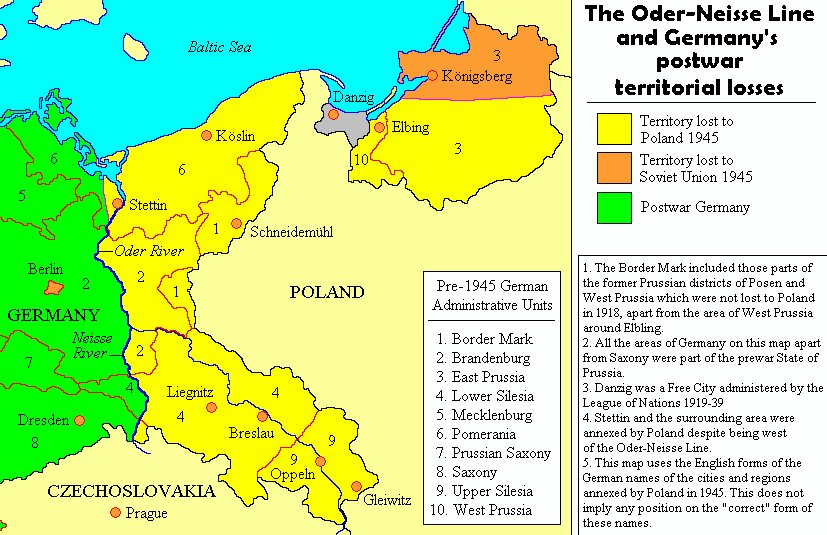
Map showing German territory lost to Poland at the end of World War II. The Oder-Neisse line (dark blue, formed by Oder and Neisse rivers) became the border between Poland and Germany. Some 31 million Germans were expelled from their homes and forced to move westward. The Oder-Neisse Line runs from Stettin, on the Baltic Sea, to the Czech border. In 1946, Churchill proclaimed, “From Stettin in the Baltic to Trieste in the Adriatic, an ‘Iron Curtain’ has descended across the continent.” Churchill’s remarks don’t take account of East Germany, which hadn’t yet arisen as a separate nation with EastBloc loyalty. The formation of East Germany meant that the Iron Curtain shifted westward, from Stettin to Travemunde/Lubeck. (Stettin is now the Polish city of Szczecin.) |
Our guide told us a grisly anecdote about Berlin during the Thirty Years War, when it was small and insignificant, and occupied by the Swedes. The Swedish soldiers would amuse themselves by grabbing a peasant, putting a funnel in his mouth, and pouring in raw sewage. Then they’d beat him to death, betting the while on how long he’d last. Though us moderns aren’t always kind, it does seem that people then were crueler, had fewer humanitarian impulses. In the last two centuries, there has been a trend toward a kinder, gentler world, though this trend has sometimes been interrupted and set back. This anecdote also illustrates how stratified society was at that time, how a peasant was regarded as hardly more than an animal. Tocqueville argued that the more stratified society was, the more inhumane people were, since they regarded other social classes as strangers, and had no sympathy for them; “We see that for several centuries,” Tocqueville wrote, “social conditions have been getting more equal and notice that at the same time mores have become more gentle.”1B
Unlike Prague, Berlin is flat, so you can’t climb a hill to get a view of the city (the word “Berlin” comes from “swamp”). There are, however, numerous tall buildings in Berlin that you can climb for a view. Perhaps the most popular is the Reichstag, where the German parliament meets; it’s free to climb to the top of the Reichstag’s glass dome, but there’s usually a long line.
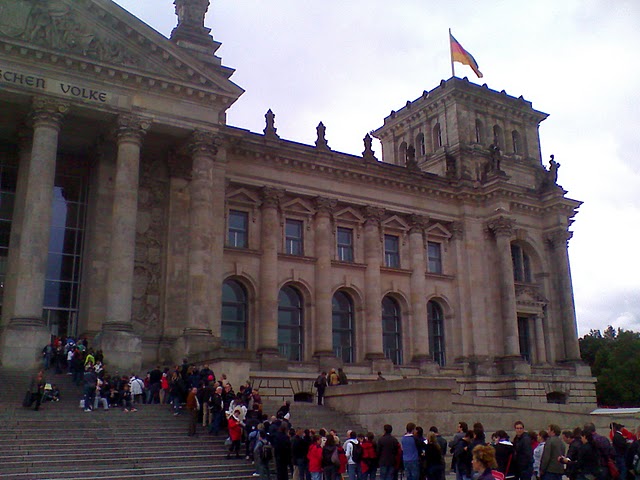
|
| The Reichstag and the queue. |
There are many plaques around Berlin, explaining history in various languages. Just west of the Brandenburg Gate is a plaque describing the protests of 1848, which occurred not only in Berlin, but throughout Europe; the people set up barricades, fought the royal troops, and forced the king to meet some of their demands. These 1848 protests might be compared to the 1989 protests that overthrew communist regimes in Eastern Europe. After 1848, however, several European monarchs were able to reassert their power. If you want to read about the 1989 revolutions, consider a book by Timothy Garton Ash called The Magic Lantern: The Revolution of 1989 Witnessed in Warsaw, Budapest, Berlin, and Prague.
An example of modern art in Berlin is the Holocaust Memorial, five acres covered with 2,700 concrete slabs — no words, no names, no pictures, no information.
I enjoyed my visit to Berlin’s Jewish Museum, which tells the story of Jews in Germany. Since the Rhine was the Roman Empire’s eastern border, the Romans built forts along the Rhine. Towns grew up around these forts, and Jews lived in these towns. So you might say that the history of German Jews goes back as far as German civilization itself.
In medieval times, towns grew up east of the Rhine, and Jews became part of medieval German civilization. A typical German town was surrounded by a wall, and Jews lived in one section of the town, where streets often had names like Judengasse, Synagogengasse, etc. Jews were usually barred from craft guilds and from farming, while Christians were usually barred from money-lending (because of laws against “usury”). So Jews gravitated toward money-lending, or worked as traders or peddlers. In medieval times, there were two particularly severe outbreaks of anti-Semitic violence: 1096, when the Crusaders passed through German towns on their way to the Middle East, and 1348, when The Plague broke out, and Jews were blamed for poisoning the wells, etc.
The Jewish Museum also discussed the modern period, and showed how the Holocaust was the culmination of the anti-Semitism that ran through the late 1800’s and early 1900’s.
While I was at the Museum, I encountered a type of person that I’ve encountered two or three times before: The Line Cutter. When my energy had run out, and I decided to leave the Museum, I got into a line at the coat-check counter. It was a rather long line — at least fifteen people. After I had waited a while, and moved up in the line, I noticed a young woman standing near me. It wasn’t clear if she was in the line or not. This was The Line Cutter. Line Cutters seem to choose their victims, their hosts, carefully; I seem to be a favorite with them, they must think I’m unlikely to resist them.
As I moved forward toward the counter, The Line Cutter moved with me, like my shadow. If I stepped in front of her, she would step forward, too, as if she were determined to keep the place that she had stolen. As you get near the end of the line, it becomes more difficult to stop the Line Cutter. Your best chance to stop him is at the first moment, when he first takes up his position. He knows that this is the key moment, so he’s careful to position himself ambiguously — you aren’t sure if he’s in the line or not — and he’s careful to avert his face so it’s harder to speak to him, to confront him. Years ago, at a circus, I encountered an elderly Line Cutter with his granddaughter; he was not only cutting, he was training the next generation of Line Cutters.
While the Jewish Museum is built in a modern style, Berlin’s older museums are built in a classical style, and stocked with objects found by early archeologists like the German Heinrich Schliemann. While the Jewish Museum is outside the city center, many of Berlin’s museums are in the city center, on Museum Island (Museumsinsel). Some German museums complain openly that their treasures were looted by the Red Army in 1945, and still haven’t been returned. Meanwhile, the countries where the treasures were first found (Greece, Turkey, etc.) say that they’re the rightful owners, and the treasures should be given back to them.
As I walked around Berlin, I was often approached by gypsy women, with scarves on their heads and dark complexions, who would start by asking, “Do you speak English?” If you were foolish enough to say “yes,” they would show you a card on which was written something like, “Bosnian woman with two children just arrived in Berlin with no food or money...” They were trying to separate you from your money, but they were doing it in a way that was organized, not in a way that was annoying or threatening. Germany has managed to organize even beggars! In earlier times, gypsies made their way to Western Europe through the Czech Republic (Bohemia), hence the adjective “Bohemian” came to mean wild, free, unconventional. Gypsies originated in northern India.
There’s also another kind of beggar, a kind that I often saw in Prague. This kind is often a white male, about 50 or 60. He says nothing, he doesn’t even look at you. Rather, he kneels on the edge of the street, and lowers his forehead to the ground, in a position resembling prayer. There’s usually an upturned hat in front of him, where people can drop money.
I met numerous travelers from Australia and New Zealand; though these countries don’t have large populations, they certainly have lots of travelers. Some of these travelers stay abroad for months, some work in England for a year or two, some visit relatives in the British Isles (they’re still in contact with their European relatives because their families left Europe quite recently).
Several people were using a system called BusAbout, which has busses circling Europe; you can hop on/hop off, and the people you ride with are travelers like yourself. A few decades ago, a similar system for trains was popular; it was called Eurail. Though Eurail still exists, it seems expensive, and I only met one person using it.
I also noticed numerous Orientals traveling — South Koreans, Japanese, Chinese. I didn’t meet many Americans or Canadians. And I didn’t meet many Russians, though I had met many in the U.S. in recent months.
Compared to Americans, Europeans seem tall; the Dutch are tall, as are the Germans, as are northern Europeans generally. Many Americans (in New England, at least) are from southern Europe (Portugal, Italy, etc.), and southern Europeans are shorter than northern. Asians and Hispanics are shorter still.
After four days in Berlin, I took a train to Prague (about a 4-hour ride). I chatted with a young Australian traveler. As we followed the Elbe between Dresden and the Czech border, he said that the landscape, with high cliffs rising from the river, resembled Switzerland. I said that others had felt the same way, so the region was called Saxon Switzerland (Sachsische Schweiz). We had a good view of the gigantic fortress of Konigstein, perched atop a high cliff.
I discovered a historian named Hans Kohn. Like Kafka, Kohn was born into Prague’s Jewish community. During World War I, he fought on the Austrian-German side, and spent five years in a Russian prison camp. Later he came to the U.S., and taught at Smith College, City College of New York, and The New School. (My mother was at Smith in the 1940’s, and she remembers Kohn as an outstanding teacher.1C) Like Elie Kedourie, Kohn often wrote about nationalism. Kedourie had a special interest in Arab nationalism (since he himself was from Iraq), while Kohn had a special interest in Slavic nationalism (since he himself was from the Slavic world). Kohn wrote a history of the Habsburg Empire between 1804 and 1918, and he wrote an autobiographical work called Living in a World Revolution: My Encounters with History.
One might compare Kohn with John Lukacs, who was also born in the Habsburg Empire (Budapest), also wrote about that empire, and also became an American academic. Among Lukacs’ many books is a book about his birthplace called Budapest 1900: A Historical Portrait of a City and Its Culture. Like Prague, Budapest had many Germans and Jews; Lukacs himself had a Jewish mother and a Catholic father. Lukacs was a friend of my old favorite, George Kennan, and Lukacs published his correspondence with Kennan. Many of Lukacs’ books are about World War II — more specifically, about Churchill and Hitler.
We should probably give Lukacs credit for being an early advocate of the view that the Soviet Union was weak and close to collapse, and therefore active American opposition to the Soviet Union was a waste of blood and treasure. Lukacs laments the decline and decadence of American society, which he sees as part of a larger trend toward the decline of elites and the rise of demagogues. This larger trend showed itself, according to Lukacs, in both Communism and Fascism. Lukacs wrote a book called A Thread of Years, which “contains a series of vignettes set in each year of the 20th century from 1900 to 1998, tracing what Lukacs regards as the collapse of the traditional American values of gentlemanly conduct and politeness and the rise of vulgarity and profanity.... Lukacs sees himself as the defender of the traditional values of Western civilization against what he regards as the debasing leveling effects of modern mass civilization.”2
John Lukacs should not be confused with Georg Lukacs, a Marxist philosopher and literary critic who was also born in Budapest.
While I was in Europe, I used Gmail (I had my e-mail forwarded to a Gmail account), and when I returned to the U.S., I decided to continue using Gmail, instead of going back to Outlook, and I decided to use GoogleCalendar, too. (I also use GoogleDocs, primarily for backups.) So I’ve jumped into the clouds, I’ve opted for cloud computing over old-fashioned, hard-drive computing.
The advantage of cloud computing is that, if I travel, or get a new computer, it’s an easier transition, because I have less important data on my hard drive (my data is in the clouds — that is, on a Google server). Also, it’s easier to backup my computer (because there’s less data on my hard drive). For years, I stayed with Outlook because it allowed me to use MicrosoftWord for writing e-mail. As I explained in an earlier issue, I use Word’s AutoCorrect feature as a shorthand system, and I was reluctant to give up this convenience. But I found a program called PhraseExpress, which is almost as good as AutoCorrect, and works in any Windows program. PhraseExpress can import a list of shortcuts directly from Word, and can turn itself on/off for selected programs. I turn it off when I’m using Word because it isn’t quite as good as AutoCorrect — it doesn’t automatically capitalize the first word in a sentence. PhraseExpress claims to be free for personal use, but then it badgers you with pop-ups until you pay, so it really isn’t free for anyone. PhraseExpress is made by a small German software company, and has lots of video tutorials, with a German accent.3
While I can do e-mail in the clouds, I’m still firmly attached to MicrosoftWord for word-processing — partly because of the AutoCorrect feature, partly because of fancy features like footnotes and indexes, and partly because of macros and shortcuts. The only way I could do word-processing in the clouds is if MicrosoftWord itself could be used online. In fact, there are online versions of several Office programs, including Word, and they can be used for free. But these online versions only offer basic features — no footnotes, no macros, no customizable AutoCorrect, etc. So for word-processing, I plan to remain on terra firma for years to come.
When I was in Europe, I tried to minimize luggage by not bringing a laptop or a camera; I tried to use an iPod in lieu of a laptop, and a cell-phone in lieu of a camera. But the iPod was somewhat clumsy for e-mail/Internet, and the cell-phone was only moderately effective as a camera.
About seven years ago, I visited Harvard’s alumni website, entered some contact information, and was annoyed that I couldn’t write freely, couldn’t discuss my thoughts/experiences. At about the same time, a Harvard undergrad named Mark Zuckerberg had a similar experience; he was annoyed that Harvard didn’t put the Class Facebook online, so he started thefacebook.com, which spread to other colleges, and gradually grew into the website Facebook.4
Zuckerberg has steadfastly refused to sell Facebook, though many large companies have made offers. “Microsoft [was] finally permitted to buy 1.6 percent of Facebook for $240 million in 2007, which at the time put the value of the company, which had yet to make a profit, at $15 billion.” (Its value now is about $34 billion.) Perhaps Zuckerberg refuses to sell because he thinks that Facebook’s future is even greater than its present, or perhaps he enjoys the excitement of being a kingpin in the new economy. Though Zuckerberg seems to be the driving force behind Facebook, and the largest shareholder, he didn’t found the company alone, and he isn’t the sole owner. Three Harvard classmates started Facebook with him; Zuckerberg’s own share is 24%. Facebook is privately held; it’s rumored that an IPO will take place in 2012.
Facebook has become a key part of the Internet, and it seems destined to become the standard way for people to present themselves in the digital world, interact with friends, etc. Facebook is digital socializing. It’s especially popular with teens, who are keen on socializing. I’ve never gotten involved with Facebook, but several people have urged me to do so, and said that it can be a platform for philosophy.
I saw a TV show about Saul Alinsky (1909-1972), who became well-known as a community organizer in the 1960’s, and has since become even more well-known, partly because Obama admires him (in fact, Alinsky may have inspired Obama’s early career as a community organizer). Alinsky’s book Rules for Radicals: A Pragmatic Primer for Realistic Radicals is now selling briskly, especially among TeaParty activists. Alinsky said he became angry when he saw people being kicked around; he tried to help people in the slums to gain a voice, to gain power. Alinsky’s method (according to his disciple, Nicholas von Hoffman) was “un-method”; Alinsky tried to learn about a community, then let what he learned dictate his approach. He was wary of government programs, and took a dim view of Lyndon Johnson’s GreatSociety project. Alinsky was known for his sense of humor, and for his integrity in financial matters. Before he became a community organizer, he worked in the labor-union movement; he wrote a biography of union leader John L. Lewis.
© L. James Hammond 2010
feedback
visit Phlit home page
make a donation via PayPal
| Footnotes | ||
| 1. | You can do some hiking at Schulpforta; I saw a trail leading uphill, and a sign pointing to “Bismarck Tower.” back | |
| 1B. | Democracy in America, II, iii, 1 back | |
| 1C. | When my mother was at Smith College, my father was at Amherst College, where he took classes with historians Laurence Packard and Dwight Salmon. back | |
| 2. | Wikipedia. Lukacs spent many years as a professor at Chestnut Hill College, where he succeeded a person whose views resembled his own: Erik von Kuehnelt-Leddihn. When Kuehnelt-Leddihn was leaving his post, he recommended Lukacs to fill it. back | |
| 3. | Besides PhraseExpress, there are many other programs that resemble AutoCorrect: AutoText, made by JitBit, isn’t good; FastFox, made by NCH, works better than AutoText, but can’t import a list of shortcuts; InstantText, made by TextWare, is a leader in the field, but it costs $189; there’s also Asutype and Robotype; click here for a list of such programs.
“I’m tired of lugging my laptop around, I’d like to use my tablet, perhaps in conjunction with a Bluetooth keyboard. Is there an AutoCorrect program for tablets?” Consider FireKeys, an Android app that can import a list of shortcuts. According to the New York Times,
| |
| 4. | “Humanity’s Database,” by David Pogue, New York Times, July 2, 2010 back | |
